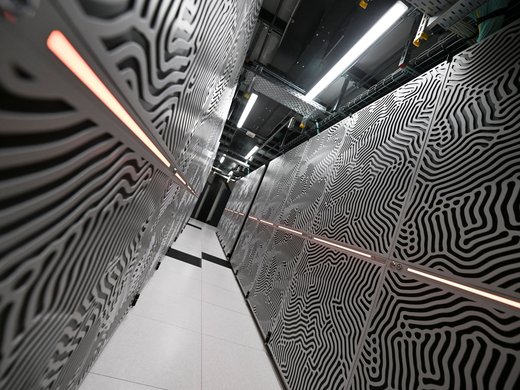Aristotle is often (mis)quoted as writing, “The whole is greater than the sum of its parts” in his work Metaphysics. Just as nineteenth-century Gestalt psychology focused on understanding perception as a whole and not just its individual components, this quotation has direct implications for governing our global information environment,1 of which data is a critical element. We need to stop looking only at the system’s components in isolation and instead address the interplay between the various elements in order to understand how to enable the fair and open information system on which our democracies rely. But notably missing from many of these discussions is the need for a fair, inclusive approach to data governance that supports and strengthens the whole of society’s engagement in a healthy information space.
The ground has shifted significantly since the Centre for International Governance Innovation (CIGI) released its Data Governance in the Digital Age series in 2018. The last six years have witnessed a slow convergence around aspects of a platform governance agenda, encompassing a wide range of technology, social and economic policies, legislation and regulation that touch on aspects of the global information environment. Governments, regulators, civil society organizations (CSOs) and even some industry partners have meaningfully worked to address the impacts of data, systems and online content on society, notably recognizing the role that very large online platforms and search engines2 continue to play in this regard.
Sadly, however, little has practically changed. Despite substantial investments of time and money, the global outlook for an open and inclusive information environment, grounded in fair, equitable data access and usage, has worsened. As UN Secretary-General António Guterres recently expressed, in a statement that could have been uttered in 2017, “Misinformation, disinformation and hate speech are fueling prejudice and violence; exacerbating divisions and conflicts; demonizing minorities; and compromising the integrity of elections” (Guterres 2024). Indeed, in many ways, bridging privacy, competition, security and safety, and data governance spaces feels less attainable now than it did six years ago. We urgently need to recognize that the information environment is an interconnected, complex system that requires a comprehensive governance approach at both the international and domestic levels. We need to work together collaboratively to address current challenges within that system, while acknowledging the varied strengths, knowledge and experiences each partner brings to the table. Experiences and lessons learned from CIGI’s Global Platform Governance Network (GPGN) offer some useful insights into how we can better achieve this.
We urgently need to recognize that the information environment is an interconnected, complex system that requires a comprehensive governance approach at both the international and domestic levels.
While responsibility for the current situation sits with democratic partners’ inaction, recent technological and societal developments have intensified the problem. Our increased reliance on online spaces during and since the global pandemic; growing authoritarian influence and on- and offline threats to global stability emerging from regional conflicts around the globe; and the meteoric rise of generative artificial intelligence (AI), built, in part, on massive levels of data capture and exploitation, have further fuelled the problems faced in 2018.3 As a result, coherent, effective governance is in retreat on a myriad of fronts, from defending democratic institutions and elections, to protecting individual privacy and security, to ensuring fair and equitable trade and market access in the digital sphere.
Project CONNIE (Collaboration & Open Networking Needs for the Information Environment) is working to address this challenge. With support from Omidyar Network, CONNIE is developing a new way to connect the myriad global networks that are working to support the integrity of the open, inclusive information space, including those focused primarily on data governance. Rather than create another network, CONNIE takes a “federated” approach, enabling partners to collaborate while retaining their autonomy and working from where they are. Taking a systems approach, CONNIE will connect current and planned activities to better enable meaningful collaboration across the information system. This approach deliberately encompasses and aligns with emerging efforts to create a data governance regime that spans and respects different jurisdictions, values and approaches, while building common ground to work together toward shared goals.
Indeed, like its subset data governance, the broad information environment cuts across a wide swathe of policy, operational and geographic divisions, each with its own unique history, community and shared experience. Public pressure to address high-profile crises across the information environment, such as coordinated, live-streamed terror attacks, foreign influence operations and disinformation, and the global collapse of independent media, have resulted in myopic and siloed solutions. Instead of considering each of these issues as part of a broader, interconnected system, democracies have tackled only specific aspects of the problem, focusing almost exclusively on the content layer of the online space, tackling challenges within domestic or regional borders and targeting symptoms such as disinformation. The absence of data governance perspectives in these largely responsive exercises is striking. When partners connect across policy and geographic silos to tackle emerging challenges in the information space, issues related to data capture, sharing, access and ownership are often excluded or addressed separately in parallel conversations; crises resulting from unfettered data extraction and exploitation rarely feature. As a result, governments, regulators, CSOs and donors continue to miss opportunities to work together, learn from one another and find new ways to approach their long-standing, seemingly intractable problems.
Public pressure to address high-profile crises across the information environment, such as coordinated, live-streamed terror attacks, foreign influence operations and disinformation, and the global collapse of independent media, have resulted in myopic and siloed solutions.
Trust, capacity, taxonomy and language, and urgency have all played key roles in leading us to this place. Many of the network initiatives that were created to link allies have focused on connecting across existing spaces and on aligning with known partners, largely within their own policy domains, rather than recognizing the gaps and working across the divides. This approach has led the fissures between these communities to become gaping chasms. As a unique subset of the problem, data governance poses a special challenge: despite being the fuel for the current AI boom, as well as the foundation on which the information system runs, data is often the missing element of these conversations.
There continues to be a flurry of activity, as politicians, regulators, academics, civil society, donors and industry have raced to “do something” to address seemingly endless crises. Since 2018, we have seen the launch of numerous solutions designed to tackle various aspects of these governance challenges. Coupled with the continued emergence of new avenues of scholarship and the launch of new networks to support that work, however, the pace and volume of this activity is overwhelming.
In fact, what is striking is the sheer number of activities under way globally, both across related networks and communities and in disconnected policy areas working in parallel on related issues. There are far too many new initiatives, reports, research projects, networks and partnerships for any one person to track who is doing what, where they are doing it and which approaches they are using, let alone trying to distill what the global community could be learning as a result. This lack of visibility and coordination between project teams means that each fails to take advantage of possible economies of scale and scope across current efforts. This has led to significant risk of duplication or initiatives operating at cross purposes. It has meant that bright spots are missed and partners with promising initiatives, especially outside the Global North, can struggle to find support. Without a process to bring these ideas together and to build from them, we are missing opportunities to accelerate emerging successes and identify cul-de-sacs. Considering this critical challenge that democracies are facing, our current structure is insufficient to handle the task.
A Potential Way Forward
Drawing upon the knowledge and experiences gained through the two years of GPGN operations (2020–2022) offers a potential way forward on how global governance for data may be created.
The GPGN’s starting premise was that individual government, civil society and multilateral partners cannot solve these problems on their own; a global problem requires a global solution. Partners need to work together to explore ways in which they can ensure effective governance for the information space. Traditional governance tools — legislation and regulation — operate in domestic spheres and reflect domestic interests. Furthermore, for many governments, media regulation, counterterrorism, technology policy, digital economy and data governance sit in different subject matter and operational areas and are overseen by different policy and legislative committees that ordinarily have little reason to interact. In fact, GPGN members recognized that the only people who had a complete picture of their governments’ operations were the tech industry’s public policy teams who worked with them.
With support from Reset and the Balsillie Family Foundation, the GPGN brought together a community of individuals working on a broad range of issues under the platform governance umbrella from countries whose values and experiences were broadly aligned and who were willing to share their successes and failures to build toward a better future.
In early 2021, the GPGN created three working groups to address questions of measuring the impact of interventions, aligning transparency reporting and collaborating on government research efforts. Each group was led by a global practitioner and worked with subject matter experts and government specialists to drive collaborative action on legislation, regulation and policies that were currently under development in home jurisdictions. The transparency working group’s report, Transparency Recommendations for Regulatory Regimes of Digital Platforms (MacCarthy 2022), provided practical advice on building and aligning regulatory frameworks, with at least one government regulator described using the report’s key questions on a regular basis in her organization’s working sessions.
Lessons Learned
Creating “networks of networks” to achieve a whole-of-society solution continues to resonate globally, as democratic partners think through how to lean on the kind of multi-stakeholder network collaboration that the GPGN fostered.4 It is worth noting that meaningful collaboration that aligns governance efforts without relying on large-scale formal agreements and cumbersome infrastructure is difficult to achieve. Without careful, dedicated attention, promising horizontal initiatives can falter.
Key to successfully aligning efforts across silos is building trust, finding genuine connection, respecting and listening to differences, and being willing to share and learn from failure as well as success. Through its work, the GPGN identified several key issues for future governance efforts that need to be emulated in future attempts to align global governance in this space.
Platform/Data Governance and the Information Space Are Broader Than We Think They Are
The impetus behind the GPGN’s work came from the recognition that many of the government actors working on aspects of digital platform governance were unaware of or disconnected from work under way in other jurisdictions or in other policy areas within their own governments. The GPGN recruited members from a broad range of digital policy areas (including countering violent extremism and online harms, digital trade and data governance, and protecting democracy) and from a wide range of 25+ countries, as well as a selection of multilateral organizations (for example, the Organisation for Economic Co-operation and Development [OECD]; the UN Educational, Scientific and Cultural Organization; UN Trade and Development; and the Council of Europe). In practical terms, collaboration across sectors and geographies often provided members with tested, usable advice that they could put into practice in their own jurisdictions.
Key Lesson Learned
- A greater variety of perspectives yields alternative approaches and useful workarounds to address apparently intractable challenges.
People and Relationships Matter More Than Position or Level
The GPGN benefited initially from 2020’s global lockdowns. It meant that people were available; even those who usually faced significant travel barriers were grounded. Virtual meetings allowed more regular conversations that effectively built community — it is far easier to schedule a one-hour meeting than to carve out the time, expenses and logistics of in-person conversations. Operating virtually meant that the network could include a greater number of Global Majority voices, as participation did not require the costs of in-person travel.
Recognizing that the right people matter regardless of their current positions, the GPGN used a snowball sample approach to build its community, leveraging trusted relationships. The team started by reaching out to colleagues from governments and regulators in North and South America, Europe and the European Union, Asia and the Asia-Pacific, and Africa. They also contacted existing networks operating in parallel that were already active in this space, including the Group of Seven Rapid Response Mechanism’s country leads; the OECD’s community working to advance transparency reporting on terrorist and violent extremist content online; the Institute for Strategic Dialogue’s Digital Policy Lab; the Christchurch Call network; the Global Internet Forum to Counter Terrorism; the Carnegie Endowment for International Peace’s Partnership for Countering Influence Operations; and the Internet & Jurisdiction Policy Network.
Rather than target high-profile heads of organizations, the GPGN approached officials at the junior or mid-range executive levels, onboarding those who were senior enough to be able to effect meaningful change, but close enough to the work not to need briefing ahead of each meeting or to require talking points. The unique makeup of the working groups brought together those “holding the pen” on drafting policy, legislation and regulation with their colleagues in other jurisdictions, alongside the legislative staff and regulators who would ultimately be enacting and overseeing their work. This gave members the opportunity to work through problems behind closed doors that would have otherwise either created lingering resentments or led to serious log jams. One of the most exciting conversations came about when the regulator and civil service members in the transparency working group nearly talked over one another in sharing their personal experiences and difficulties with drafting and applying new legislation.
Key Lessons Learned
- Building relationships among those accountable for results yields meaningful collaboration that can effect real change.
- Work with the right people, not the right positions.
People Need a Safe Space to Connect
From the start, the GPGN recognized the value in limiting its membership to government (broadly defined) and a small number of outside partners. Whether they were regulators, civil servants or political staff, network members reported feeling that they could speak openly about their challenges and successes without needing either to explain “how government works” or sharing too much with organizations that might use this information for their own ends. Although bringing together a broad array of partners through a whole-of-society approach is essential to addressing the challenges that we face, the GPGN recognized early on that there was nowhere for government representatives to build connections that did not also include either industry representatives or those seeking external funding for their projects.
Network members also reported being heard and not simply being talked at. The group intentionally did not open up space for transatlantic superpowers to push their agendas. Instead, the GPGN tried to apply a global focus, bringing together a wide range of experts, including some from the Global Majority, to ensure that all members understood the benefits of creating tools that had global application. For example, immediately following the January 6 insurrection, American colleagues were able to confide in and learn from their South American and African colleagues who had worked through similar crises in the past. Subsequent work with colleagues in Ukraine and Sub-Saharan Africa validated this working approach by highlighting the frustrations that partners had previously found in having Global North experts parachuting in to offer largely academic perspectives.
Key Lessons Learned
- Truly safe spaces allow people to share their setbacks and concerns instead of just focusing on successes.
- In many cases, Global Majority partners have been facing these issues for longer periods of time and have developed effective, nuanced solutions that can be applied more broadly.
Allowing All Partners to Maintain Their Autonomy
The GPGN aimed to demonstrate the importance of building partnerships among individuals approaching these issues from different perspectives, including from parallel disciplines, regions or political approaches. Members of the network recognized the value in hearing about others’ experiences with similar challenges in other regions and from other policy areas (for example, network members working to combat online hate and learning about regulatory approaches taken to address data privacy). Others noted that the network meetings were sometimes the only place where they could speak openly with legislative staff, regulators and civil servants from their own countries. Some were able to use the meetings to build their own internal bridges within their own bureaucracies, having learned about initiatives moving forward in other parts of their own governments through network conversations. The GPGN was asked by members to enable their leaders to meet through international visits and to foster collaboration on new legislative measures.
There is a vast array of actors working in this space. Instead of either duplicating efforts or attempting to crowd out existing players, the network made a concerted effort early on to work with as many partners as possible to build on their successes, learn from their mistakes and amplify their important work. When learning of a new, innovative approach to one of the issues covered by network members, the GPGN team would invite the researchers to present their findings to the network. For example, when launching its working groups, the network recruited leading experts to enable these groups to build on work already under way and contribute to global conversations. Leveraging the Atlantic Council’s previous work on transparency, for example, provided regulators who were designing transparency mechanisms in their own countries with a set of questions that they could use to help focus efforts. Similarly, when the performance measurement group was tackling the challenge of identifying “success” in this space, the GPGN worked with the Social Science Research Council to apply their HuMetrics tool, initially designed to identify values-based approaches for universities (Agate et al. 2020), to help members think through the overall goals of their own national efforts.
Key Lessons Learned
- Being able to spot a problem does not mean that you are the right organization to address it.
- Before starting something new, it is always worth determining whether others have already been working to address similar challenges.
- We do not need to conform or entirely align with one another to achieve related goals: recognizing and building from difference is a strength.
Where Do We Go from Here?
The pressure of addressing what feels like relentless, ongoing crises across the information space, coupled with historic, structural and vertical governance and accountability issues, has democratic governments and CSOs largely tackling information threats in a disjointed fashion, often ignoring underlying data governance challenges. Connecting well-intentioned government and CSO networks across geographic, policy and operational silos, as well as creating the space for community building, information sharing and learning, is needed to direct global efforts toward a coherent, system-wide response. We must ensure an open, inclusive democratic future for the information environment, with effective data governance at its centre. To borrow terminology from law enforcement, collaboration, when well-managed, can create a “force multiplier effect.” Or, in musical terms, what makes a choir great is not the best voices, but instead the ability of its members to work together to create something that exceeds the sum of their parts.
To that end, we need to double down on efforts to bring together those working across policy, operational and geographic divides, and especially to ensure a central place for data governance in those conversations. Aligning governance efforts focused on all aspects of the information environment is essential to effecting meaningful, measurable change. Based on learning from the GPGN and subsequent efforts to bridge divides, it is CONNIE’s intention to help by linking activities and plans, reducing duplication, supporting faltering efforts, and amplifying and celebrating emerging bright spots.
Democratic societies must move past tactical-level decisions aimed at developing individual solutions to global systems challenges. The current approach risks putting the underlying goals of a free, open, transparent and democratic online (and offline) space at risk. As with the wars on drugs and terrorism, the time has come in which democratic societies have to discard their initial approaches and reset for what lies ahead. We need to stop reacting to the past in order to build what we want to achieve together for the future.



